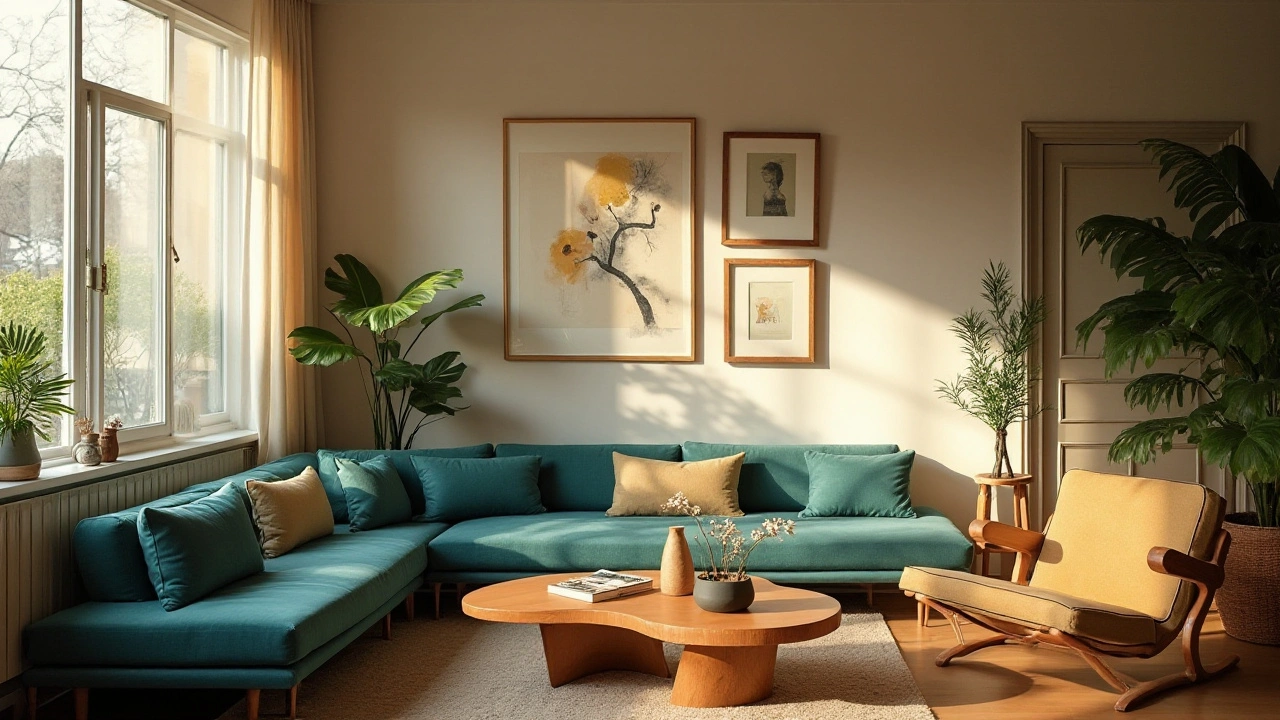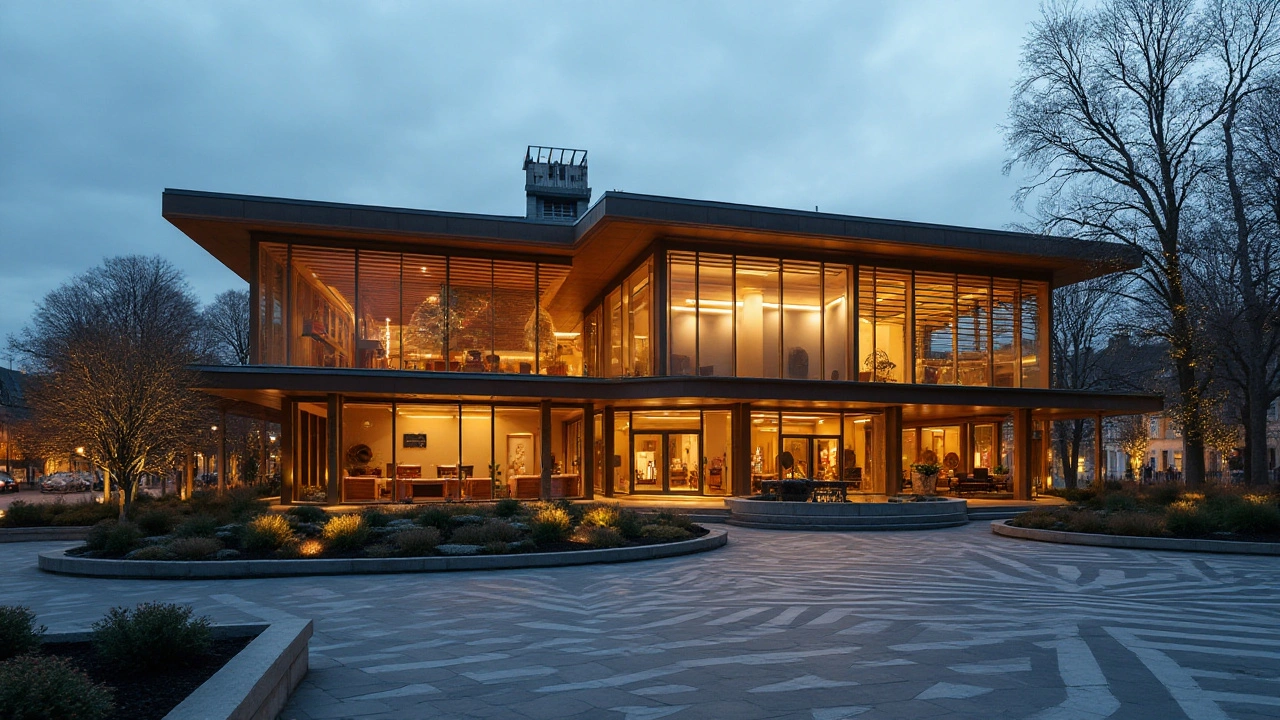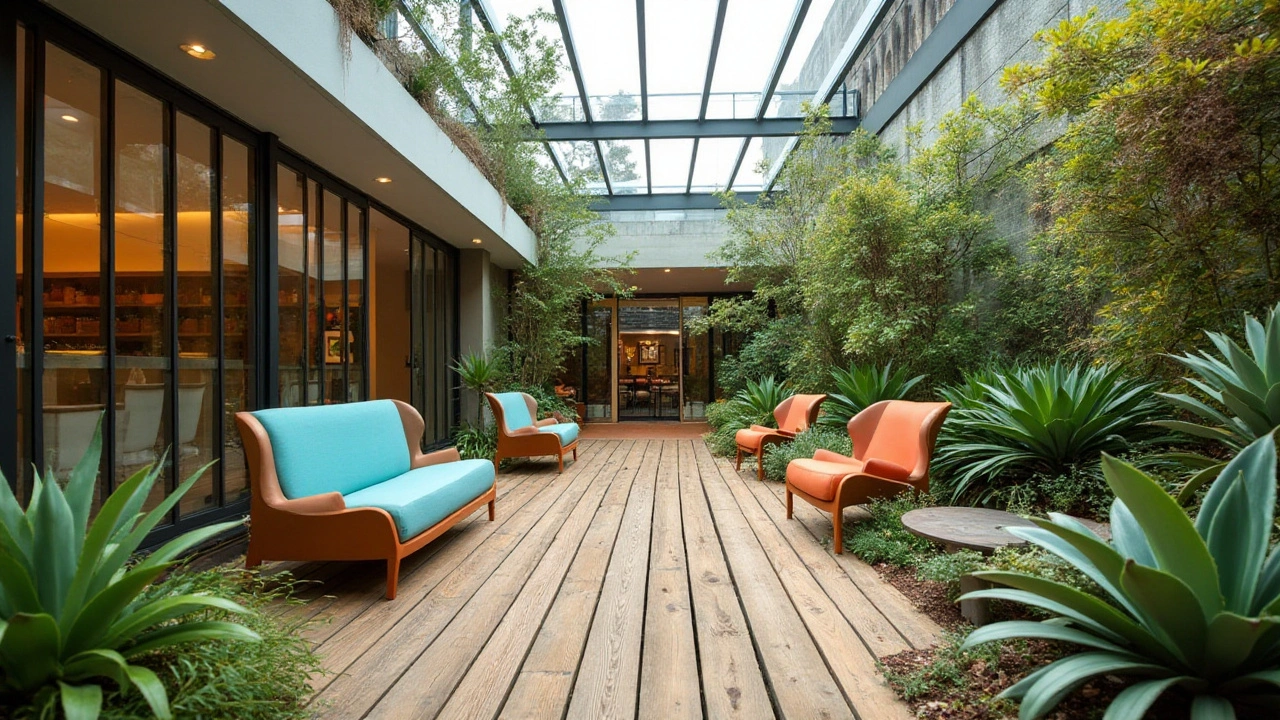Exploring the Essence and Influence of Mid-Century Modern Design
 Feb, 3 2025
Feb, 3 2025
Emerging in the wake of World War II, the Mid-Century Modern movement marked a turning point in design philosophy. As societies sought fresh beginnings, this era embraced simplicity fused with a distinctive flair. Architects and designers harnessed the renewed optimism of the times, crafting spaces that combined functionality with aesthetics.
With an emphasis on clean lines and organic forms, the style celebrated the beauty of minimalism while prioritizing utility. The harmonious blend of these elements became a trademark, resonating across generations. Through its exploration, we uncover how Mid-Century Modern transformed living environments and continues to inspire contemporary trends.
- Origins and Historical Context
- Defining Characteristics
- Influential Architects and Designers
- Impact on Interior Design
- Contemporary Revival and Influence
Origins and Historical Context
The Mid-Century Modern movement, which emerged around the middle of the 20th century, was a vibrant response to the shifting cultural landscapes of the post-war world. This period saw a myriad of changes as societies struggled to rebuild and redefine themselves after the devastation of World War II. The movement was not birthed in isolation; rather, it was a blend of influences that reflected contemporary advances in technology, materials, and a newfound optimism about the possibilities of modern life. As people returned to peace, there was a palpable sense of renewal and a desire to embrace an innovative future, and this sentiment vividly manifested itself in the designs of the era.
One could trace the roots of the Mid-Century Modern aesthetic back to the Bauhaus movement of the 1920s and 30s. The Bauhaus school, founded by Walter Gropius, imparted a philosophy that sought to harmonize functionality with artistic vision, promoting a form-follows-function ethos that would become central to Mid-Century design. This philosophy was adeptly carried across the Atlantic by several European architects fleeing the war, finding fertile ground in the United States. The economic prosperity of the post-war era created a fertile environment for experimentation with new materials, such as plywood, plastics, and metal, which were previously limited to industrial uses. Designers like Charles and Ray Eames began incorporating these materials into residential designs, pioneering a shift toward practicality without sacrificing aesthetic appeal.
The movement's development was also closely tied to the cultural climate of America during the 1950s and 1960s. There was a conscious shift away from ornate and formal European styles, towards a cleaner, more simplified aesthetic that favored open-plan living spaces and an integration with nature. The concept of 'bringing the outside in' became a crucial mantra, leading to iconic architectural designs that leveraged expansive windows and multipurpose living areas. The likes of Frank Lloyd Wright, who had long advocated for organic architecture, found renewed appreciation during this time. His philosophy emphasized the unity of human habitats with their surrounding environment, influencing the construction of iconic 'Usonian' homes. As Wright himself articulated,
"Space is the breath of art."
The international reach of Mid-Century Modern design was tremendous. It was an era marked by cultural exchanges that spanned continents. Scandinavian influence, with its love for simplicity and natural materials, melded seamlessly with American modernism, giving rise to a cross-pollination of ideas that fueled innovative explorations in design. The intermingling of these cultural ideals facilitated a body of work that was aesthetically diverse yet unified by similar principles of design purity and innovation. A remarkable aspect of this movement was its democratic nature—design became accessible to the masses. Mass production techniques made it feasible to furnish homes with stylish yet affordable pieces, giving rise to an enduring aesthetic that echoed ordinary life while celebrating extraordinary design.
Defining Characteristics
The Mid-Century Modern movement set itself apart with a blend of simplicity and inventiveness, creating a distinctive style that beckoned to both residents and designers. Exemplifying this were the crisp, clean lines and the absence of unnecessary ornamentation, which allowed for functionality to shine. It was about making the best use of space with minimalistic beauty, ensuring that each piece of furniture or architectural detail served a purpose. This aesthetic echoed the social optimism of the era, capturing the essence of progress and innovation in every angle and curve.
The use of natural materials was another hallmark, tying interiors closer to the outdoors. Wood elements, especially teak and walnut, featured prominently in furniture design, imparting warmth and an organic feel. Large windows and open floor plans emphasized the movement’s core principle: let the outside in. Glass walls and sliding doors erased the boundaries between the interior and exterior worlds, celebrating light-filled spaces that enhanced the lived experience. Architecture during this period strove not just to house occupants, but to mold their daily experiences with a seamless connection to nature.
Function-driven design didn't sacrifice color and texture. The palette often leaned towards bold and muted hues; earthy tones were punctuated with splashes of avocado green, mustard yellow, and deep orange. These choices weren't random; they were a conscious effort to reflect the natural world while injecting energy and vibrancy into the spaces. Patterns too, such as geometric and abstract motifs, were employed sparingly yet effectively, adding dimension and intrigue without overwhelming the eye. The ethos of 'less is more' prevailed, guiding creators to strike the perfect balance between subtlety and statement.
Embracing New Materials
This design movement was not just about looking backward at traditional materials; it celebrated the new. Innovative materials such as fiberglass, plastic, and plywood found their way into homes, driven by the desire for affordability and durability. These materials allowed designers to experiment with new shapes and forms that were previously impossible. Iconic pieces like the Eames Lounge Chair and the Noguchi Table emerged from this experimentation, representing the ingenuity and creativity of the age. In fact, Charles and Ray Eames articulated this ethos best when they said, "The role of the designer is that of a very good, thoughtful host anticipating the needs of his guests." These words set a directive for form to follow function without forfeiting elegance.
| Material | Common Use |
|---|---|
| Teak Wood | Furniture, Flooring |
| Plywood | Furniture, Structural Components |
| Fiberglass | Chairs, Decorative Elements |
Another feature that often surprises newcomers to Mid-Century Modern design is its adaptability. The versatile nature of this style has enabled it to morph itself into diverse settings, making it suitable for various households. Whether in a sprawling suburban home or snug city apartment, its principles can be adapted to maximize both beauty and function. Thus, its pervasive influence is evident not only in the past but also in today's design practices, informing new generations as they reimagine spaces with a touch of thoughtful nostalgia.

Influential Architects and Designers
The mid-century modern movement burgeoned thanks to a cohort of visionary architects and designers who left indelible marks on the design landscape. These creative minds reshaped our spaces and broadened our understanding of what architecture and design could achieve. Among the luminaries of this era stood Charles and Ray Eames, a husband-and-wife duo who revolutionized furniture design with their innovative use of materials and ergonomic principles. Their iconic Eames Lounge Chair remains a quintessential symbol of modern elegance, seamlessly marrying comfort with aesthetics. The pair believed in taking risks within their creativity and made it their ambition to bridge art and everyday living.
Another towering figure is Frank Lloyd Wright, who, while not exclusively a mid-century modernist, had a profound influence on the movement. Wright’s embrace of organic architecture, where structures harmonized with their environment, inspired countless contemporaries. His philosophy laid groundwork for what would become signature elements of the design movement—flowing spaces, natural materials, and an open-plan approach. The likes of Mies van der Rohe contributed the phrase 'less is more,' encapsulating the movement's minimalist ethos. His Farnsworth House encapsulates this principle with its transparency and elegant restraint.
Design was not confined to architecture, as seen in the works of George Nelson, an essential figure whose contributions as a designer and writer helped articulate the movement's values. With pieces like the Nelson Bench and his insightful observations, he sought to democratize good design, making aesthetically pleasing, functional items accessible to all. Quoting Nelson himself:
"Design is not just what it looks like and feels like. Design is how it works."This line of thinking resonates deeply within the mid-century modern philosophy.
Pioneers such as Eero Saarinen pushed boundaries with bold designs that married futuristic aesthetics with practicality. His Tulip Chair emerged as an icon of modernist innovation, emphasizing simplicity by eliminating legs clutter. Innovators like Richard Neutra brought their genius to residential architecture, emphasizing indoor-outdoor living and highlighting the importance of environment-responsive designs. The reverence for nature and simplicity continues to thrive in today’s interior design world, where the synergy between function and style remains a pivotal aspect.
International figures, too, left their imprint. Brazilian architect Oscar Niemeyer infused mid-century modernism with a lyrical quality, demonstrating that curves could be as integral as straight lines in modern architecture. His designs, such as the Niterói Contemporary Art Museum, display how mid-century modernism could embrace a diverse cultural lexicon. Through these architects and designers, the movement has touched every corner, inspiring spaces that prioritize humanity's interaction with their environment. This wave of revolutionary thinking transformed the everyday, making thoughtfully designed spaces not just available, but desirable all across continents.
Impact on Interior Design
The embrace of Mid-Century Modern in the realm of interior design has left an indelible mark, expanding even beyond the post-war era it first flourished in. This movement introduced an authentic simplicity that resonated with the chaos-weary populace. Achieving a delicate balance between form and function, interiors designed during this era emphasized open floor plans, a stark contrast to the more compartmentalized structures of earlier times. These spacious layouts were not only about aesthetics but enhanced connectivity, fostering a sense of community within residential spaces. The practicality of everyday living was celebrated, without sacrificing style, which was a refreshing change from the ornate embellishments that dominated preceding styles.
The use of natural materials like wood, stone, and leather further defined the Mid-Century interior, bringing the outside in and creating a seamless link between the natural world and the home environment. The focus on earthy tones alongside bright accent colors spoke to the optimism and the yearning for newness of the post-war generation. Such harmonious design choices created a foundation for spaces that felt both warm and inviting. The juxtaposition of a rich walnut sideboard with a splash of teal in textile accessories sparked visual interest while remaining grounded in simplicity.
Furniture, a keystone of Mid-Century Modern interior style, featured sleek lines and organic shapes, offering pieces such as the iconic Eames Lounge Chair that were as much about comfort as they were about aesthetics. One of the defining principles was to design with the practical needs of users in mind, without compromising on visual appeal. “Design is the appropriate combination of materials in order to solve a problem,” Charles Eames famously stated, encapsulating the ethos of a generation of designers focused on integrating beauty with utility. These furnishings were typically built to be lightweight and easily movable, reflecting the era's sociocultural shift towards a more mobile, adaptable lifestyle.
The impact of this movement on interior spaces was not isolated to residential developments. Commercial spaces, including offices and retail environments, also adopted the Mid-Century Modern aesthetic, creating atmospheres that were both professional and approachable. These spaces often featured full-length windows that maximized natural light, fostering an open and inviting ambiance that could improve workplace morale and customer experience. It's telling that this design philosophy, originally cultivated decades ago, continues to be heralded in interior design forums, often echoed in the layouts of contemporary coworking spaces and open-plan living areas.
Additionally, the integration of technological innovations was a defining aspect of Mid-Century interiors. Built-in storage solutions, multifunctional furniture, and clever lighting designs began to emerge, illustrating how technology and design could marry to address real-world needs. These thoughtful design choices have a lasting legacy, often visible in the emphasis on user-friendly layouts that mark modern homes and offices. The ongoing popularity of Mid-Century Modern design speaks to its timeless appeal, continually drawn upon by designers to this day as they create spaces that aspire both towards beauty and practicality—a testament to the movement's enduring influence.

Contemporary Revival and Influence
The resurgence of Mid-Century Modern design in contemporary interiors speaks volumes about its enduring appeal. This revival isn't just a nod to nostalgia but an appreciation for the timeless qualities this design encapsulates. As modern society veers towards minimalism, the movement's emphasis on clean lines and simple forms resonates more than ever. The connection between indoor and outdoor spaces, a hallmark of the style, aligns seamlessly with today's eco-conscious design ethos.
Homeowners and designers alike are rediscovering the charm of iconic mid-century furniture pieces, such as the Eames Lounge Chair and the Noguchi Coffee Table. These items haven't merely become collectibles; they are integral elements that tie together a modern aesthetic. This trend isn't limited to residential settings. Corporate environments and public spaces are also embracing these designs, particularly because of their adaptability and understated elegance. It's this versatility that enables them to coexist with current technological advancements without losing their simplistic beauty.
One might wonder why a design movement that's over half a century old remains so influential today. According to Tim Shea, a renowned interior designer, "The strength of mid-century design lies in its ability to adapt. Its functionalist roots make it ideal for modern needs." This adaptability is not only reflected in the style's visual aspects but also in construction techniques. Contemporary designers often incorporate sustainable materials while adhering to the movement’s emphasis on efficiency.
The vibrant hues and bold patterns, which characterized much of mid-century aesthetics, offer an antidote to the often subdued palettes of modern minimalism. The playful color schemes can add dynamism to any space, attracting a new generation of enthusiasts eager to inject personality into their homes. Meanwhile, the exploration of organic shapes ensures that the original philosophy remains intact. Today's revival often involves revitalizing vintage pieces with new upholstery or finishes, merging authenticity with innovation.
Design movements that echo mid-century principles continue to evolve. The popular Scandinavian design shares this focus on simplicity and function, creating a natural partnership that appeals to today's homeowners. The blending of these styles encourages a fresh look that remains firmly grounded in the principles of well-thought-out design. Whether featured in magazines, television shows, or social media platforms, mid-century elements prevail, demonstrating their role as a cultural touchstone.
For those looking to incorporate this design movement into their homes, a balance of old and new is essential. Begin with statement pieces that draw the eye and build your space around them. Let natural light highlight the open layouts and functional furniture that define mid-century interiors. Incorporating greenery also captures the essence of indoor-outdoor harmony, a crucial aspect of mid-century architecture.